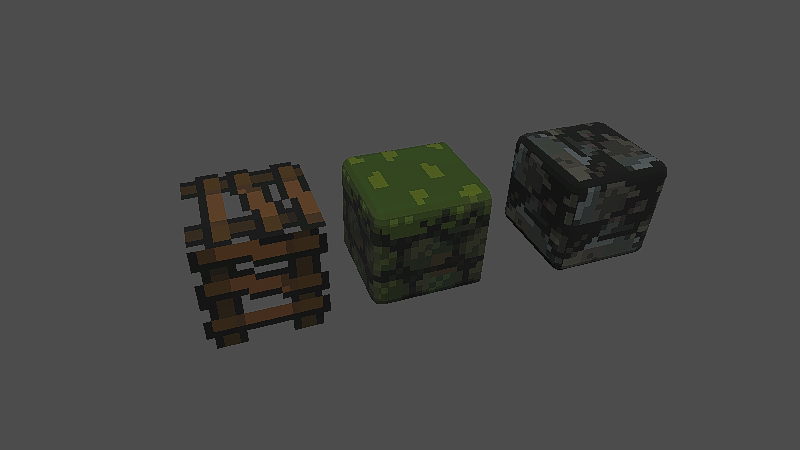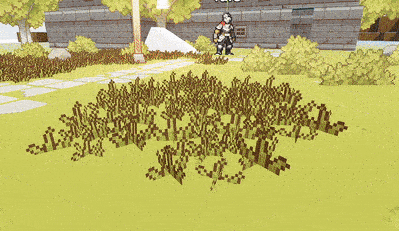Pixel Art Tileset Texture Mapping with Trim + Animation (Godot 4)
This shader builds on top of my other tileset texture mapping shaders by adding a trim along the side faces.
The trim is also based on a tileset image.
The trim can also be animated by adding additional tile indexes to trim_front/trim_back/trim_left/trim_right.
Shader Parameters:
model_dimensions: set to bounding box of model to stretch textures. Optionally set to base tile size to repeat textures. For instance if my base tile size is 1x1x1, but I have a tile model that is 2x1x1, I can keep this value as 1x1x1 to repeat textures, or set it to 2x1x1 to stretch texturestileset_texture: the tileset you wish to use, tiles should be the same size and uniformly spacedtile_size / trim_tile_size: the size of the tile in pixelsblend_tiles: leave false if your object has slopesblend_sharpness: how sharp of a blend between tilestop/bottom/front/back/left/right: Arrays of tile indexes to display, additional indexes beyond 1 will result in the texture animating. 0 is reserved and won't display any tile that might be in the top left corner of your tilesettrim_front/trim_back/trim_left/trim_right: Same as the above but for trimanimation_speed: the speed of the animation
Shader code
shader_type spatial;
render_mode cull_disabled;
uniform vec3 model_dimensions = vec3(1.0, 1.0, 1.0);
uniform vec2 tile_size = vec2(16.0, 16.0);
uniform float texture_scale : hint_range(0.1, 10.0) = 1.0;
uniform bool blend_tiles = false;
uniform float blend_sharpness : hint_range(0.0, 10.0) = 2.0;
uniform int top[10];
uniform int bottom[10];
uniform int front[10];
uniform int back[10];
uniform int left[10];
uniform int right[10];
uniform float animation_speed;
uniform sampler2D tileset_texture: source_color, filter_nearest, repeat_enable;
uniform sampler2D trim_texture: source_color, filter_nearest, repeat_enable;
uniform vec2 trim_tile_size = vec2(16.0, 16.0);
uniform int trim_front[10];
uniform int trim_back[10];
uniform int trim_left[10];
uniform int trim_right[10];
varying vec3 instance_pos;
varying mat4 model_matrix;
void vertex() {
instance_pos = MODEL_MATRIX[3].xyz; //Position of Instance, supports MultiMeshInstances in the use of GridMaps
model_matrix = MODEL_MATRIX;
COLOR = vec4(0.1,0.1,0.1,0.0);
}
int getArraySize(int[10] arr) {
int size = 0;
for (int i = 0; i < arr.length(); i++) {
if (arr[i] != 0) {
size++;
}
else {
break;
}
}
return size;
}
vec4 get_base_tileset(vec3 world_position, vec3 normal) {
vec3 weights = abs(normal);
weights = pow(weights, vec3(blend_sharpness));
weights /= dot(weights, vec3(1.0));
if (!blend_tiles) {
float threshold = 0.7071;
vec3 equal_weights = vec3(0.0, 1.0, 0.0); // Higher weight for top texture
weights = mix(equal_weights, weights, step(threshold, max(weights.x, max(weights.y, weights.z))));
}
vec2 tileset_dimensions = vec2(textureSize(tileset_texture,0)) / tile_size;
vec2 tile_uv_scale = tile_size / vec2(textureSize(tileset_texture,0));
vec2 tile_offset[6];
int frontSize = getArraySize(front);
int backSize = getArraySize(back);
int topSize = getArraySize(top);
int bottomSize = getArraySize(bottom);
int leftSize = getArraySize(left);
int rightSize = getArraySize(right);
int frontFrame = int(mod(TIME * animation_speed, float(frontSize)));
int backFrame = int(mod(TIME * animation_speed, float(backSize)));
int topFrame = int(mod(TIME * animation_speed, float(topSize)));
int bottomFrame = int(mod(TIME * animation_speed, float(bottomSize)));
int leftFrame = int(mod(TIME * animation_speed, float(leftSize)));
int rightFrame = int(mod(TIME * animation_speed, float(rightSize)));
tile_offset[0] = vec2(mod(float(front[frontFrame]), tileset_dimensions.x), floor(float(front[frontFrame]) / tileset_dimensions.x)) * tile_uv_scale;
tile_offset[1] = vec2(mod(float(back[backFrame]), tileset_dimensions.x), floor(float(back[backFrame]) / tileset_dimensions.x)) * tile_uv_scale;
tile_offset[2] = vec2(mod(float(top[topFrame]), tileset_dimensions.x), floor(float(top[topFrame]) / tileset_dimensions.x)) * tile_uv_scale;
tile_offset[3] = vec2(mod(float(bottom[bottomFrame]), tileset_dimensions.x), floor(float(bottom[bottomFrame]) / tileset_dimensions.x)) * tile_uv_scale;
tile_offset[4] = vec2(mod(float(left[leftFrame]), tileset_dimensions.x), floor(float(left[leftFrame]) / tileset_dimensions.x)) * tile_uv_scale;
tile_offset[5] = vec2(mod(float(right[rightFrame]), tileset_dimensions.x), floor(float(right[rightFrame]) / tileset_dimensions.x)) * tile_uv_scale;
float margin = 0.001;
vec4 colors[6];
vec2 uv;
uv = (-world_position.zy / model_dimensions.zy + 0.5 - vec2(-((model_dimensions.z - 1.0) / (2.0 * model_dimensions.z)))) * texture_scale;
colors[0] = texture(tileset_texture, fract(uv) * tile_uv_scale + tile_offset[0]);
uv = (-world_position.zy / model_dimensions.zy + 0.5 - vec2(-((model_dimensions.z - 1.0) / (2.0 * model_dimensions.z)))) * texture_scale;
colors[1] = texture(tileset_texture, fract(uv) * tile_uv_scale + tile_offset[1]);
uv = (world_position.zx / model_dimensions.zx + 0.5 + vec2(-((model_dimensions.z - 1.0) / (2.0 * model_dimensions.z)), -((model_dimensions.x - 1.0) / (2.0 * model_dimensions.x)))) * texture_scale;
colors[2] = texture(tileset_texture, fract(uv) * tile_uv_scale + tile_offset[2]);
uv = (world_position.zx / model_dimensions.zx + 0.5 + vec2(-((model_dimensions.z - 1.0) / (2.0 * model_dimensions.z)), -((model_dimensions.x - 1.0) / (2.0 * model_dimensions.x)))) * texture_scale;
colors[3] = texture(tileset_texture, fract(uv) * tile_uv_scale + tile_offset[3]);
uv = (-world_position.xy / model_dimensions.xy + 0.5 + vec2(((model_dimensions.x - 1.0) / (2.0 * model_dimensions.x)),((model_dimensions.y - 1.0) / (2.0 * model_dimensions.y)))) * texture_scale;
colors[4] = texture(tileset_texture, fract(uv) * tile_uv_scale + tile_offset[4]);
uv = (-world_position.xy / model_dimensions.xy + 0.5 + vec2(((model_dimensions.x - 1.0) / (2.0 * model_dimensions.x)),((model_dimensions.y - 1.0) / (2.0 * model_dimensions.y)))) * texture_scale;
colors[5] = texture(tileset_texture, fract(uv) * tile_uv_scale + tile_offset[5]);
vec4 color = weights.x * (normal.x > 0.0 ? colors[0] : colors[1]) +
weights.y * (normal.y > 0.0 ? colors[2] : colors[3]) +
weights.z * (normal.z > 0.0 ? colors[4] : colors[5]);
return color;
}
vec4 get_trim_tileset(vec3 world_position, vec3 world_normal){
vec2 uv;
int trim_index;
int frontSize = getArraySize(trim_front);
int backSize = getArraySize(trim_back);
int leftSize = getArraySize(trim_left);
int rightSize = getArraySize(trim_right);
int frontFrame = int(mod(TIME * animation_speed, float(frontSize)));
int backFrame = int(mod(TIME * animation_speed, float(backSize)));
int leftFrame = int(mod(TIME * animation_speed, float(leftSize)));
int rightFrame = int(mod(TIME * animation_speed, float(rightSize)));
if (abs(world_normal.x) > 0.5) { // Left or right face
uv = world_position.zy;
trim_index = world_normal.x > 0.0 ? trim_right[rightFrame] : trim_left[leftFrame];
} else if (abs(world_normal.z) > 0.5) { // Front or back face
uv = world_position.xy;
trim_index = world_normal.z > 0.0 ? trim_front[frontFrame] : trim_back[backFrame];
}
uv = uv / model_dimensions.xy + 0.5;
uv.y = 1.0 - uv.y;
uv *= texture_scale;
vec2 trim_tileset_dimensions = vec2(textureSize(trim_texture,0)) / trim_tile_size;
vec2 trim_tile_uv_scale = trim_tile_size / vec2(textureSize(trim_texture,0));
vec2 trim_tile_offset = vec2(mod(float(trim_index), trim_tileset_dimensions.x), floor(float(trim_index) / trim_tileset_dimensions.x)) * trim_tile_uv_scale;
vec4 trim_color = texture(trim_texture, fract(uv) * trim_tile_uv_scale + trim_tile_offset);
return trim_color;
}
void fragment() {
vec3 world_position = (INV_VIEW_MATRIX * vec4(VERTEX, 1.0)).xyz - instance_pos;
vec3 world_normal = (INV_VIEW_MATRIX * vec4(NORMAL, 0.0)).xyz;
vec4 albedo = get_base_tileset(inverse(mat3(model_matrix)) * world_position, inverse(mat3(model_matrix)) * world_normal);
vec4 trim_color = get_trim_tileset(inverse(mat3(model_matrix)) * world_position, inverse(mat3(model_matrix)) * world_normal);
bool is_trim_fragment = trim_color.a > 0.1;
bool is_on_target_face = abs(world_normal.x) > 0.5 || abs(world_normal.z) > 0.5;
vec4 final_color = is_on_target_face && is_trim_fragment ? trim_color : albedo;
if (final_color.a <= 0.1) {
discard;
}
ALBEDO = final_color.rgb;
}






This shader is great, but why the top and bottom textures are centered? Can I apply an offset to them to make them appear like the trimmed one?
screenshot